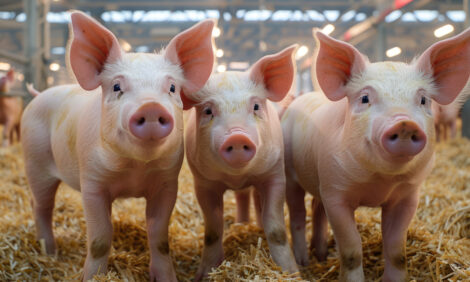



Factors that affect Feet and Leg Soundness
By Todd See, NCSU Swine Extension - The National Animal Health Monitoring System (2001) reports that structural, including feet and leg problems, unsoundness is the reason for removal of 16 percent of the culled swine breeding herd and accounts for 7.3 of the death loss in finishers. Factors that may affect structural soundness include genetics, level of production, sex, nutrition, disease, floor surface, equipment location and space.
 Dr Todd See
Dr Todd SeeSwine Genetics Specialist North Carolina State University |
Skeletal Structure
Research indicates that skeletal structure is moderately heritable and, therefore, best improved through selection of breeding animals. Selection for feet and leg soundness is a subjective, visual process that should be part of progressive pork production.
Skeletal structures in Figures 1 and 2 were drawn, in part, as the result of radiological examination of live pigs. Undesirable front and rear leg structure is indicated in Figure 1 and desirable bone conformation is illustrated in Figure 2.
The rear leg structure in Figure 1 has a rump that is too steep and a tail that setting is too low. The angle of the rear leg (N) is larger in Figure 1 than in Figure 2. The hip (E), stifle (F), and hock joints (G) lock in a straight-line position with each step or in the breeding-mounted (boar) position. Boars whose rear legs are too straight will occasionally fall backward and sit down when mounting. The rear feet may exhibit excessive sole wear with subsequent swelling of the pad and lameness. The spine (Figure 1) is arched very highly. The angle (M) is greater than 90 degrees, which positions the shoulder blade bone more directly over the front leg bones. Additional pressure may be applied at the elbow joint (B) and at the knee joint (C) to compensate. The front leg knee joints will often buckle. The abnormally straight front leg posture in Figure 1 results in abrasive wear of the pads and toes.
In Figure 2, note the flatter top, more level rump, and higher tail setting. The front legs slope from the shoulder, as you view them from the side, resembling a curved sickle blade. The angle (M) allows for the normal shock-absorbing effect at the elbow joint (B). The angle (N) in Figure 2 is smaller than in Figure 1. The rear leg joints are properly angled to allow the hip, stifle, and hock joints to absorb pressure equally. The pasterns (D) are sloping and long to provide a cushioning effect, and the toes rest squarely on the floor surface.
Figure 3 illustrates a sample scoring system and the common structural deficiencies of the feet and legs of pigs. Evaluation of these deficiencies with reference to normal structure can be used in a scoring system to evaluate and select replacement breeding animals. In this system, both the front and rear legs are evaluated and scored individually. The sum of the rear and front leg scores should ideally be 7 or higher in animals selected for breeding.
Improvement of Feet and Leg Soundness
Here are seven ways to improve foot and leg soundness in a swine herd and promote more profitable performance of the animals:

Figure 1. Undesireable front and rear leg structure.

Figure 2. Desireable front and rear leg structure.
Genetic suppliers and multipliers should evaluate all breeding herd candidates at a standard age or weight.
Commercial producers should purchase sound replacement animals from genetic suppliers with a soundness, scoring-culling system and with facilities similar to their own.
Avoid the use of adverse environmental conditions, i.e., rough floors and inadequate pen space.
Feed nutritionally balanced diets.
Provide consistent, best management practices on a daily basis to all pigs.
Separate lame or injured pigs from the group.
Recognize that it may take several generations of selection to attain acceptable structural soundness. Structural soundness is just one trait that must be considered and compromise is usually required in the selection process to improve the population in overall merit.

Source: North Carolina State University Swine Extension - October 2004









